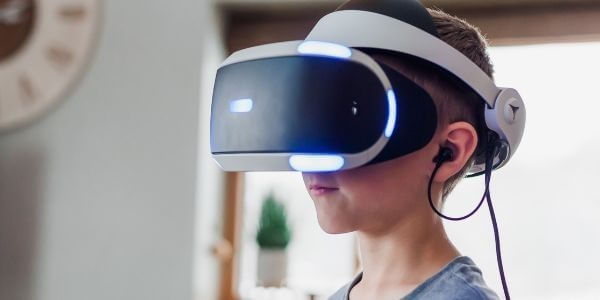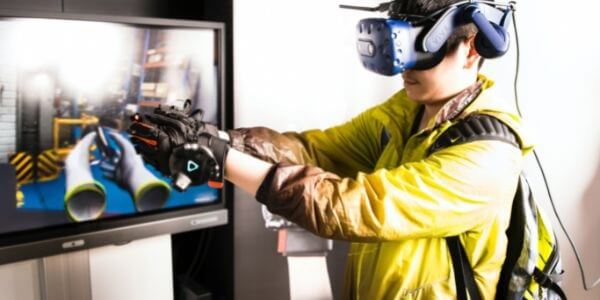The Most Reliable Parental Control App
FamiSafe lets parents control screen time, track real-time location and detect inappropriate content on kids' devices.
Virtual reality is slowly becoming a key component of a digital lifestyle. Several platforms offer different experiences, and the gadgets are also making their way into school curriculums. On Christmas Day, the oculus app rushed to the top in the app store, proving that VR is becoming a very popular gift among kids.
However, there is still raging debate on whether the devices are suitable for children. As you keep reading, you will discover all you need to know about these devices and whether or not you should get one.
$FB “Downloads of the companion Oculus app were up 153% year-over-year this Christmas.” pic.twitter.com/8FoXTSjnpg
— Francisco Olivera (@FrancoOlivera) December 31, 2021
Part1: The Advantages of getting VR for Kids.
Advantage 1They help your kids see a bigger world.

Virtual reality allows your kid to see the world in a new light. They can expand their horizons by simulating real-life situations through the different platforms and learn essential skills in the process. For example, STEM learners use the platform to explore space and learn about the planets and different constellations. As such, they can perceive complex problems from the comfort of their living rooms or classrooms.
Advantage 2They can share comparisons with other kids.
Virtual reality allows your children to interact with others from different locations. Through the platform, they can share ideas and exchange experiences, enabling them to learn from each other outside the classroom.
In addition, sharing comparisons helps them integrate a more global mentality, where they are able to accept other cultures and see how different people experience life in the real world. For example, platforms like Google Earth allow them to visit exotic locations and compare their life experiences with others.
Advantage 2Virtual reality motivates your kids to learn.
Several early childhood development centers now use virtual reality as teaching aids for their students. In addition, virtual reality apps present an alternative learning method that is fun and engaging. In turn, your child is motivated to attend school and learn things easier, especially if they suffer from learning difficulties.

Part2: The Disadvantages of getting VR for Kids
Despite the numerous advantages of virtual reality, some parents and child experts highlight the disadvantages of getting a VR set for your kid. Here are some of the concerns they raise about virtual reality.
Disadvantage 1Virtual reality is bad for eye health
There are reports of children developing sight problems from engaging with virtual reality gadgets. Typically, eye problems develop from overexposure, given that most virtual reality games feature bright colors and alternating images.
Therefore, it is important to ensure that you set brightness and contrast levels that are suitable for your kid. Most VR gadgets feature brightness settings that you can set directly from the device or from the platform.
Disadvantage 2VR games can be dangerous both physically and mentally (game addiction).
Another reason for concern from parents and child experts is the risk of game addiction from using virtual reality. Most game developers design their games to be extra engaging, which can result in your child neglecting other important tasks such as school assignments. In addition, they can develop other mental health issues such as social isolation, where they lose touch with reality and only focus on VR gaming.
Furthermore, there are reports of children injuring themselves when VR gaming. This is because wearing a VR gadget isolates you from the real world, and you are unaware of what is happening around you. For example, if your child uses the gadget in an enclosed area, they are more likely to bump into stuff and hurt themselves.
Disadvantage 3They lack parental control.
Unfortunately, virtual reality gadgets do not feature proper parental control features. As such, your kid is vulnerable to online threats such as cyberbullying and extortion. In addition, several VR headset manufactures advice against children using their devices without adult supervision. For example, HTC explicitly says that children should not use their devices. On the other hand, both Samsung and Google list the recommended age for their VR devices as thirteen and above.
Disadvantage 4VR can lead to balance issues in your child.
According to a study by Leeds university on the effects of virtual reality, engaging with these devices can lead to balance issues. This is because these devices offer different images for each eye in an attempt to indicate depth.
However, the image is an illusion which can lead to problems with determining distances. Fortunately, these effects are only short-term, and limiting exposure to virtual reality is enough to mitigate the problem.
Disadvantage 5Exposure to explicit content
According to The Center for Countering Digital Hate, virtual reality offers increased exposure to explicit content. For example, one of their videos shows one user sharing a video on child abuse. In addition, they also have multiple reports of children receiving sexually explicit messages and instances of child grooming.
Meta, the company behind the VR Oculus headset, indicates that their platform VR chat is a cross-platform application. As such, using their app allows you to connect with other VR users from different service providers like Steam VR and Windows. Therefore, monitoring the content, your child receives when using their devices is extremely difficult.
However, in a recent statement, the company pledges to commit $50 million to make its platform safer for all users. Some of the programs they plan to invest in better parental controls and vet their developers.
Disadvantage 6They lose interest with it very quickly
Kids tend to lose interest in their toys very easily. For example, how many toys do you have in storage boxes of old toys your kid no longer uses? Similarly, getting them a virtual reality set may not be a good idea especially if the device offers limited access to games. In addition, some games may be hard to master which can lead to frustration on your kid. Unless they figure it out, they will leave the gadget and opt for something where they are having fun.
Disadvantage 7Virtual Reality Headsets and VR Games are expensive
Typically, new technology is always expensive to acquire. For example, the Oculus Quest 2 by Meta retails at $299 on Amazon, which makes it out of reach for most families. Similarly, the accompanying software also commands a premium making the initial investment an expensive affair.
As such, getting a VR headset for your kids may not be a worthy investment, especially when they are prone to lose interest in the gadget very quickly. In addition, only a few companies offer useful content to meet your kids’ interest. Therefore, unless more companies embrace the idea and start offering cheaper sets in the market, the investment may not be worth it.
Part3: How to protect kids' cyber life?

Given the above information, there are valid arguments for the benefits and disadvantages of using virtual reality. However, researchers are still trying to understand the long-term effects of using these platforms. Therefore, how do you protect kid's cyber life?
Famisafe is a reliable parental control app you can use to ensure your child is safe when interacting online. The app is by software developer Wondershare, which features plenty of useful features to ensure your children's total protection. Some of the app’s incredible features include safe search, website filter and screen time limiter that you can enable when your subscription is active.
Tap this video to get some insights on kids’ online safety.
Wondershare Famisafe
FamiSafe lets parents control screen time, track real-time location and detect inappropriate content on kids' devices.

Conclusion
So, should you buy a VR set for your kids? Based on the information above, there is still a lot of unknowns with this new technology. Researchers are still conducting studies to determine the exact benefits and so far, most of the information is from small sample sizes to be conclusive. In addition, most of the content is from a few companies and focuses on paid-access gaming. Therefore, the best course of action is to wait until the devices and accompanying software becomes affordable.
